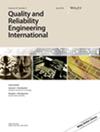Sensitivity and reliability comparisons of EWMA mean control chart based on robust scale estimators under non‐normal process: COVID data application
IF 2.8
3区 工程技术
Q3 ENGINEERING, INDUSTRIAL
引用次数: 0
Abstract
Robust control charts are getting vital importance in statistical process control theory as they are insensitive to the departure from normality. Therefore, the main objective of current work is to determine the effects of non‐normal process on the Exponentially Weighted Moving Average (EWMA) control chart. To achieve this goal, the sensitivity and reliability comparisons are made under the non‐normal process by comparing five robust M‐scale estimators, suggested in literature to modify the EWMA control limits for monitoring process mean and on the basis of percentile bootstrap estimator. The paper addresses the run length (RL) distribution of a robust EWMA control chart under the non‐normal process for which the exponential distribution is used as non‐normal process. The standard deviation of RL, out‐of‐control average run length (ARL), and shift detection probabilities are examined to assess the sensitivity and reliability of robust EWMA control charts for mean of monitoring process. The results of this research indicate that the classical EWMA control chart's performance is substantially impacted by the non‐normal distribution and the proposed EWMA control charts show higher sensitivity than classical one in terms of having smaller values of out‐of‐control ARLs. A real‐life example from the medical sciences field is provided the practical usage of the proposed control charts. The simulation analysis and practical example have shown that the suggested control charts are effective in quickly monitoring the out‐of‐control process.非正态过程下基于稳健标度估计器的 EWMA 均值控制图的灵敏度和可靠性比较:COVID 数据应用
稳健控制图对偏离正态不敏感,因此在统计过程控制理论中越来越重要。因此,当前工作的主要目标是确定非正态过程对指数加权移动平均(EWMA)控制图的影响。为实现这一目标,本文通过比较文献中提出的五种稳健 M 标度估计器,对非正态过程下的灵敏度和可靠性进行了比较。本文讨论了非正态过程下稳健 EWMA 控制图的运行长度(RL)分布,其中使用了指数分布作为非正态过程。研究了 RL 的标准偏差、失控平均运行长度 (ARL) 和偏移检测概率,以评估鲁棒 EWMA 控制图对监控过程均值的灵敏度和可靠性。研究结果表明,经典 EWMA 控制图的性能会受到非正态分布的严重影响,而建议的 EWMA 控制图比经典控制图具有更高的灵敏度,其失控 ARL 值更小。一个来自医疗科学领域的真实案例提供了建议控制图的实际应用。仿真分析和实际案例表明,建议的控制图能有效地快速监控失控过程。
本文章由计算机程序翻译,如有差异,请以英文原文为准。
求助全文
约1分钟内获得全文
求助全文
来源期刊
CiteScore
4.90
自引率
21.70%
发文量
181
审稿时长
6 months
期刊介绍:
Quality and Reliability Engineering International is a journal devoted to practical engineering aspects of quality and reliability. A refereed technical journal published eight times per year, it covers the development and practical application of existing theoretical methods, research and industrial practices. Articles in the journal will be concerned with case studies, tutorial-type reviews and also with applications of new or well-known theory to the solution of actual quality and reliability problems in engineering.
Papers describing the use of mathematical and statistical tools to solve real life industrial problems are encouraged, provided that the emphasis is placed on practical applications and demonstrated case studies.
The scope of the journal is intended to include components, physics of failure, equipment and systems from the fields of electronic, electrical, mechanical and systems engineering. The areas of communications, aerospace, automotive, railways, shipboard equipment, control engineering and consumer products are all covered by the journal.
Quality and reliability of hardware as well as software are covered. Papers on software engineering and its impact on product quality and reliability are encouraged. The journal will also cover the management of quality and reliability in the engineering industry.
Special issues on a variety of key topics are published every year and contribute to the enhancement of Quality and Reliability Engineering International as a major reference in its field.

 求助内容:
求助内容: 应助结果提醒方式:
应助结果提醒方式:


